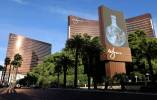At CityCenter, firsts are foremost
The $8.4 billion CityCenter has already attracted international attention for its status as the largest private-sector development ever built in the United States (which means it’s almost certainly one of the world’s — nay, the universe’s — biggest private projects ever, though we haven’t been to Mars et al to confirm this).
But its price tag isn’t the only singular thing about the massive megaresort opening on the Strip this week. From claiming the only fire station at any Strip resort to having the largest glass wall at any public building in the country, CityCenter has racked up a dizzying roster of firsts and biggests. In the process, the resort has created new supply chains, forged fresh markets and yielded emergent technologies.
Here are just a few of CityCenter’s firsts.
WHAT IT IS: Control4 smart-home technology
Why it’s different: It’s the first time a major hotel-casino has deployed door-to-drapes home-automation technology in all of its guest rooms.
Consumers who dwell in the rarefied confines of newer custom homes know all about “smart-home” technology. For those of you who live in “stupid” homes, here’s how such wizardry works: A push of a remote-control button can adjust all your preferred settings as you come home, reconfiguring your lighting, curtains, temperature and electronics all at once.
At Aria and Mandarin Oriental, that means rooms will know if it’s your first time there. The television will greet you by name. Lights will come on and curtains will open when you first enter your room or suite. A single remote control will let you control lighting, temperature, TV and video systems, music, wake-up calls, draperies and room-service requests. You can also select “scenes” — say, for example, a “goodnight” setting that turns off lights and TVs, shuts curtains and turns on the do-not-disturb notice. After you check out, an unoccupied setting turns off the lights, air conditioning and electronics to conserve energy. And when you make a return visit, the hotel database will remember your preferences. In all, CityCenter has more than 100,000 automated devices.
“It’s part and parcel with Las Vegas — it’s on a scale people can’t really comprehend,” said Glen Mella, president and chief operating officer of Utah-based Control4. “This has really upped the ante for that one-touch experience for the guest.”
It took Control4 two years to create CityCenter’s system, and the company had to develop or find technology for elements that don’t exist in homes (for example, room service), as well as integrate control systems with the hotel’s property-management software.
Where you’ll see it next: The Harmon, set to open at CityCenter in late 2010. Control4 also installed energy-efficiency and home-theater systems inside the 1,200 suites inside Planet Hollywood’s PH Towers timeshare, opening in late December, and thermostat systems inside the Golden Nugget’s new tower. Control4 has been selling door-to-drapes packages to newer boutique hotels, such as the 200-room Montage Beverly Hills and the 125-room Rosewood Sand Hill in Palo Alto, Calif. The 391-room Trump SoHo New York will deploy a comprehensive Control4 system when it opens in 2010.
WHAT IT IS: Limousines that run on alternative fuel
Why it’s different: It’s the world’s first stretch-limousine fleet powered entirely with compressed natural gas.
MGM Mirage officials went with compressed natural gas burners because the United States has abundant reserves of natural gas. Plus, compressed natural gas releases fewer greenhouse-gas emissions than gasoline does, so the fleet complements the company’s focus on environmental responsibility at CityCenter. It’s also less expensive and more price-stable than gasoline or diesel fuel.
The biggest obstacle? The gas tank. CNG tanks take up four times as much space as gasoline tanks, and engineers had to develop a design that accommodated the bigger tank but didn’t eat into the limousines’ trunk space. MGM Mirage paid for the engineering and crash-testing.
The 26-limo fleet, which Krystal Enterprises of California developed with Clean Energy Fuels, BAF Technologies and Ford, serves Aria Resort & Casino and Vdara Hotel & Spa.
Where you’ll see it next: Krystal is marketing the limousines to other transportation companies, but it doesn’t have any commitments right now.
WHAT IT IS: High-end, low-flow plumbing fixtures
Why it’s different: They combine good looks with efficiency in the first mass-produced high-style, low-use water faucets.
It’s news to us because we’ve never built a megaresort, but apparently, in the world of plumbing fixtures, commercial developers have always had just two options: Pretty but wasteful, or miserly but unattractive. CityCenter executives wanted low-flow faucets and shower heads to advance their push for sustainability, but they also needed fixtures that would fit the resort’s high-minded design. So they used their buying power to single-handedly yield the elusive Holy Grail of plumbing fixtures — beautiful efficiency for large-scale projects.
“They were looking for a certain style. They were trying to come up with something that was not available five years ago (during the resort’s planning), something that would be leading technology that could pull the industry into thinking about water consciousness and style at the same time,” said Bob Baskett, a salesman with Delta Faucet.
When officials with Delta heard about CityCenter’s plans, their “eyes lit up like Christmas trees,” Baskett said. Retooling factories for a whole new product line ain’t cheap, so manufacturers would need an order count of at least 4,000 to make a new invention worthwhile. CityCenter had more than 6,000 rooms to decorate, plus an ongoing need for replacement fixtures and parts. It took a ton of back-and-forth between engineers and designers to come up with a workable prototype, but the result is a new type of plumbing fixture that’s now widely available to other commercial developers.
Where you’ll see it next: In your house. Low-flow showerheads similar to those at CityCenter are available for about $50 through Delta’s Web site (click on Smart Solutions and go to the H2Okinetics entry; look for the square and flat, round versions). The sink faucets, alas, are proprietary to MGM Mirage, so if you see them anywhere else, it’ll be in another company-owned resort.
WHAT IT IS: Homegrown stone quarried in Jean
Why it’s different: It’s the first Cradle to Cradle-certified rock ever used in a local megaresort.
Maybe we’re stating the obvious here, but stone is heavy. Many resorts and commercial projects transport stone from other continents in a process that consumes a lot of energy. So CityCenter officials wanted a local alternative for at least part of the resort.
They found the perfect rock — a multicolored, swirled and flecked reddish stone from the 79-year-old Rainbow Quarries — half an hour away, in Jean. Even better than its close location was its status as a Cradle to Cradle-certified product. Cradle to Cradle, a standard established by the McDonough Braungart Design Chemistry consultancy in Virginia, measures a product’s recyclability and water efficiency during manufacture, among other ecofriendly gauges.
CityCenter isn’t the first public or commercial building in Southern Nevada to use the Jean stone, but it’s the first to apply the rock on a large scale. CityCenter has about 80,000 square feet of the stone on its exterior. That’s compared to 10,000 square feet around the door at the Regional Justice Center downtown, or about 15,000 square feet at the Science and Engineering building at the University of Nevada, Las Vegas.
Dan Rhoades, vice president of Las Vegas Rock, sold the stone to CityCenter. He said the project’s high profile has already boosted the Jean rock’s popularity.
“A lot of architects and builders have been exposed to it, and we’ve definitely gotten a good response,” Rhoades said. “We’re getting a lot of calls and sending out a lot of samples.”
Where you’ll see it next: The Cosmopolitan, scheduled to open in 2010, will use about 60,000 square feet of the stone in its spa. Consumers can buy the stone for countertops and floors at home. Its cost varies depending on thickness and finish, but it usually runs about 50 percent cheaper than granite or marble, Rhoades said.
WHAT IT IS: CityCenter’s cogeneration plant
Why it’s different: The megaresort’s power plant is the first combined-cycle heating and power plant on the Strip.
Giving CityCenter its own power plant accomplishes two objectives.
First, by placing power generation next to its end user, less energy is lost to diffusion along far-flung transmission lines.
More importantly, though, the station allows CityCenter to capture the waste heat that’s a byproduct of power generation and use it to heat the resort’s water supply — hence the “cogeneration” tag.
Overall, the 9-megawatt cogeneration plant also means CityCenter will use less power, and that has the macroeconomic effect of helping the country reduce its reliance on finite supplies of fossil fuels from foreign lands, said Cindy Ortega, senior vice president of MGM Mirage’s energy and environmental services division.
Where you’ll see it next: Probably in any future megaresort, because it’s easy to include when starting a development from scratch and “it’s a best practice,” Ortega said. “When I started in this role four years ago, this (cogeneration plant) was the aspiration. Now it’s the baseline. For projects that come in the future, this will be the starting point. I would expect the next project to have the next generation of power production.”
WHAT IT IS: Large-scale recycling of construction waste
Why it’s different: It’s the first time a Strip megaresort’s foundation was built using materials recycled from the property that preceded it.
The Boardwalk is a faint memory, but pieces of the hotel-casino, which occupied CityCenter’s lot before it came down to make way for the new resort, make up part of CityCenter’s parking garage and base.
That’s just a small example of the construction-recycling ethos at CityCenter. Reusing or recycling is a key criterion for any development aiming for certification through the U.S. Green Building Council’s Leadership in Energy and Environmental Design program. And MGM Mirage wanted LEED Gold status, the program’s highest level.
There was just one problem: No companies existed that could handle the sheer volume of construction waste that would come from an 18 million-square-foot project. So MGM Mirage helped an existing recycler, Evergreen Recycling, with capital to expand its facilities (Evergreen’s owners kicked in $15 million themselves, too). Over time, Evergreen ramped up from around 40 employees to roughly 100, and it built a 50,000-square-foot automated recovery center. At the project’s peak, Evergreen was handling 200 tons, or 50 truck loads, of construction waste daily. In all, CityCenter has yielded roughly 130,000 tons of recyclable construction matter. For comparison’s sake, consider that the entire Las Vegas Valley recycles just 50,000 tons a year.
Growing to accommodate CityCenter has transformed Evergreen into a large-scale operation that’s recycled construction waste at myriad other local projects, including the Veterans Affairs hospital under construction in North Las Vegas and the Vegas PBS building on Flamingo Road. Evergreen has so much business that it won’t need to let go of any of the employees it hired in the runup to serve CityCenter, said Len Christopher, Evergreen’s chief executive officer. The company’s work even earned it a 2009 Environmental Achievement Award from the U.S. Environmental Protection Agency.
“It was a great experience for us. No one can really say they’ve ever done something like what we did at CityCenter,” Christopher said. “There’s no other project like it in the country.”
Where you’ll see it next: In future Strip resorts and other commercial projects. Boyd Gaming Corp., for example, was aiming for LEED status and thus recycling construction debris on a large scale at Echelon when it halted the project in August 2008. Plus, now that the capacity exists for handling huge volumes of construction debris, recycling building waste won’t add costs to future developments, Ortega said.
WHAT IT IS: Sustainable wood
Why it’s different: CityCenter is the first megaresort to collect national honors for using ecofriendly woods exclusively.
As it did with construction-waste recycling, CityCenter singlehandedly created a local market and supply chain for sustainably harvested woods. Ten Las Vegas wood suppliers received chain-of-custody certification through the Forest Stewardship Council-US, verifying that the wood they supply didn’t come from rare or endangered stands of trees and that it didn’t contain harmful chemicals such as formaldehyde.
The red tape involved in certification was enough to deter many suppliers. But MGM Mirage persisted, and its efforts earned it Best Commercial Project of 2009 honors from the FSC-US.
The process wasn’t easy for anybody. Manufacturers, for example, would have to drain their glue lines of conventional veneer glue, clean the glue lines, and run through that whole process again once a sustainable wood had run through their assembly line. And becoming a certified sustainable-wood provider took close to eight months for Complete Millwork, said Lester Robertson, the Carson City company’s chief executive officer.
Almost as tough as earning certification was actually finding suitable wood. Requests from CityCenter designers ranged from the obscure — one designer wanted wood reclaimed from the bottom of Canadian lakes — to the virtually impossible, such as a complete tree of organically darkened English oak for Wolfgang Puck’s brasserie inside Crystals. Robertson found and snagged the only two logs available in the United States.
Robertson estimated that FSC woods are about 20 percent more expensive than conventionally grown and manufactured woods.
Where you’ll see it next: Robertson said he’s receiving sizable numbers of orders for FSC-certified wood from California, where tax incentives have spurred developers to use the products
WHAT IT IS: The Mandarin Oriental
Why it’s different: It’s not just Mandarin Oriental’s first Nevada foray, it’s also the first nongaming hotel with Strip frontage.
Sure, Mandalay Bay broke ground when it attached itself to the Four Seasons, a boutique hotel with no slots or table games. But Mandarin Oriental takes it a little further: It’s a noncasino boutique hotel with direct access to pedestrian traffic on the Strip. In fact, the Mandarin Oriental seems to encourage Strip foot traffic, what with its Amore Patisserie fronting the resort corridor. The Four Seasons is set well back from the Strip and is visible only to those who approach it via car.
“(Mandarin Oriental) is definitely something new. The brand itself is a luxury brand you certainly wouldn’t have seen here 20 years ago,” said David G. Schwartz, director of the Center for Gaming Research at the University of Nevada, Las Vegas.
But Bill Thompson, a UNLV professor who specializes in gambling studies, said including a boutique hotel with no casino on the Strip is, in a way, just more of the same for the resort corridor.
“I think it’s nice, but that’s what Vegas does — we do nice things and then we do nicer things,” Thompson said.
Where you’ll see it next: It’s uncertain which developer might build the next nongaming hotel with Strip frontage. It all depends on how the concept fares, Schwartz said.
WHAT IT IS: High-density, urban-style development
Why it’s different: It’s the first Strip resort to fit so much space and so many uses onto one plot.
To understand just how compact a development CityCenter is, compare it with Bellagio next door. Bellagio’s 76-acre lot houses 6 million square feet of space, while CityCenter’s 67 acres contains 18 million square feet of space. Among the uses are the traditional gaming, spas, restaurants and high-end retail, but CityCenter also includes 2,400 residences, three nongaming boutique hotels, public art and even a planned grocery store at Vdara. The idea is to negate the need for public transportation, much like big-city downtowns allow residents and visitors to meet all their needs in a contained area.
Where you’ll see it next: It depends on what kinds of projects future capital makes possible, though the price of land on the Strip almost necessitates big projects with multiple elements. Boyd’s delayed Echelon figured to be dense and multiuse as well, with several boutique hotels, a major hotel-casino, 750,000 square feet of space, numerous theaters and retail space on 87 acres. But Echelon is on hold for the next three to five years, and it’s unclear whether the property will return in the same scope or size.
WHAT IT IS: A server-based casino floor
Why it’s different: It’ll be the first Strip casino run entirely through networks allowing operators to switch out games virtually.
Aria opens with about half of its 1,940 slot machines on International Game Technology’s sbX Floor Manager and Media Manager, a server-based network. IGT officials said they expect to have the rest of the slots online within a month or so.
So what’ll you see when you sit down at a slot inside Aria? For one thing, you’ll be able to choose from about 70 games, because the server allows for interoperability among manufacturers, said Julie Brown, a spokeswoman for IGT. Also, if you slip an MGM Mirage players’ club card into a slot machine, a window will pop up on the screen welcoming you and detailing your point balance.
The system benefits MGM Mirage, too: Aria managers can communicate with players on the spot, pushing out last-minute offers to shows, restaurants, slot tournaments or other promotions. Plus, they can change out games and denominations with the flick of a switch.
Brown acknowledged that sbX carried upfront costs for Aria, including networks and other technology. But the hotel-casino will save on labor, because it needs fewer slot technicians to move around machines or replace chips to switch out games.
Consumers leery of having their play or preferences tracked by server can opt out by not using players’ cards with the machines.
Where you’ll see it next: Undetermined. “Everyone is on a wait-and-see basis with Aria, because (sbX) is a game-changer,” Brown said. “A lot of operators are waiting to see how it goes at Aria.” To experience server-based gaming elsewhere, slip into the Monte Carlo, where IGT has been conducting a four-month test run on about 100 machines.
Contact reporter Jennifer Robison at jrobison@reviewjournal.com or 702-380-4512.
RELATED STORIES
• THE CRESCENDO: Newest, most expensive joint on the Strip opens with fireworks, fanfare
• JANE ANN MORRISON: Wear comfortable shoes, stylish clothes to see all of CityCenter
• Bellagio exhibit a primer on CityCenter art, architecture
• Everywhere You Look
• Moving to the Big City



















